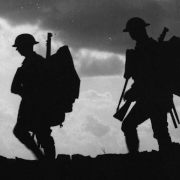|
NightGyr posted:We're building a plane we don't know how to fly or arm. drat this rushed production thing is messed up. I don't like the F-35 program much, but this statement is ignorant of how modern combat aircraft are developed. These kinds of trials are completely normal in every way.
|
|
|
|

|
| # ? May 16, 2024 14:17 |
|
I had no idea spitfires were ever in US service, that was pretty cool. more info: http://spitfiresite.com/2010/04/uncle-sams-spitfires.html
|
|
|
|
Snowdens Secret posted:How realistic is a scenario where an entire enemy armored column exposes itself, yet the US has such complete air superiority that we can lumber a heavy bomber across the sky without even worrying about SAMs? Outside of Iraq, that is, where the land/air mix was all sorts of off in foolish ways long before hostilities started. Was there a time where we really thought we could be putting B-52s over a hot Fulda Gap? As others have said the CBU-97/-105 is deliverable by just about everything that is CBU capable, which is pretty much everything in the US/western inventory, from tactical fighters to strategic bombers. The only limiting factor would be that in order to effectively employ the -105 you'd need an aircraft that is -1760 bus capable, but even then that's pretty much every aircraft in the inventory, now that the A-10s have that capability. As you might imagine, the munition was originally developed specifically for a Fulda Gap type scenario, to be the ultimate tank fucker...where a tactical fighter could scream in at low level, drop the weapon in the general vicinity of the armor, and scream away while letting the munition do the tank destroying instead of having to hang around to make sure the munition guided or to take the time to employ dumb munitions on the armor. MrYenko posted:I don't like the F-35 program much, but this statement is ignorant of how modern combat aircraft are developed. These kinds of trials are completely normal in every way. Yeah, I think my F-35 hatred is well established but that's not a fair statement at all. The munitions integration aspect of the program has been relatively drama free. That said, this mlmp08 posted:Hahaha, 2x jdams and 2x AMRAAM is not impressive. At least it can carry a pile of SDBs to precision kill soft air defense and comm targets. is why Bob Gates is a loving retard about airpower. 4xAMRAAM (what the F-35 carries in a A2A loadout) is not a suitable substitute for an aircraft with better kinematic performance that carries 6xAMRAAM and 2xSidewinder. Also are we taking bets on when the F-35 integrates SDB? I'm betting 2020, maybe 2025 depending on how the rest of the program progresses. The Raptor is just now finally getting it, SIX YEARS after it went IOC on the Mud Hen. Spiral development is fun! And it's worth mentioning that the Raptor can carry the exact same amount of SDBs (8, 2 BRU-61s worth) as the F-35 is going to be able to internally. Except it can do so while supercruising at 50K+ feet. So again, thanks Gates.
|
|
|
|
iyaayas01 posted:And it's worth mentioning that the Raptor can carry the exact same amount of SDBs (8, 2 BRU-61s worth) as the F-35 is going to be able to internally. Except it can do so while supercruising at 50K+ feet. So again, thanks Gates. Its almost like we decided to cancel the good airplane, and buy the cheaper, inferior substitute, which then ended up being more expensive! Isn't procurement fun?
|
|
|
|
LP97S posted:I don't know how Cold War this is but have Taistelukenttä. It's a Finnish Defence Force video from 1998 that shows bits of a hypothetical war with some force that uses Russian equipment, emphasis on Finns getting shot and other bits. Skip to about 2:30 in case you get tired of the Finnish tourism ad in the beginning. Spotted a TKIV 85 sniper Mosin at 15:53.
|
|
|
|
MrYenko posted:I don't like the F-35 program much, but this statement is ignorant of how modern combat aircraft are developed. These kinds of trials are completely normal in every way. Obviously you need to build test models, but isn't the production schedule for something like 90 of them before the test program is finished?
|
|
|
|
NightGyr posted:Obviously you need to build test models, but isn't the production schedule for something like 90 of them before the test program is finished? Concurrency is a very real issue with the program, and something I have criticized in the past...but making these integration tests sound like Lockmart and the govt just went "LET'S BUILD A FIGHTER GUYS WHOOPS FORGOT TO HAVE IT CARRY WEAPONS GUESS WE'D BETTER GO BACK AND DO THAT AND CHARGE THE TAXPAYER BILLIONS FOR IT WHOOOO!!!!" is pretty inaccurate. Every single US fighter jet since at least the teen-series (to include the F-35, more or less) has followed the same basic progression: build some prototypes (or two designs if you're doing a fly-off), do proof of concept tests utilizing the prototypes, get the go ahead to enter low-rate production, and conduct weapons/avionics integration and performance demonstration tests using these first low-rate production jets while also beginning to develop/train the cadre you'll need to stand-up the schoolhouse. There have been a few variations on this theme (the F-14's spin-off development from the failed F-111B comes to mind) but that's the basic progression. The problem is that as fighters have gotten more advanced there have been a host of related issues that have conspired to throw this seemingly relatively straightforward progression seriously out of whack. As fighters get more complex, they cost more. Buying more is the easiest way to get the per unit cost down...but the more something costs up front the harder it is to buy a lot of them. The Raptor attempted to solve this problem through utilizing what's called spiral development. This is where you field a basic version of the aircraft to get iron on the ramp while keeping costs down and then program the money for upgrades to the full up package into the years following. This has the advantage of keeping costs lower than if you got a full up aircraft right from the start, but it has one significant disadvantage: in the years following you are beholden to the guys holding the purse strings. They can either delay the money for significant upgrades (which occurred with the Raptor...which is why the Raptor is just now integrating the SDB and why it still can't employ the AIM-9X) or they can straight up refuse to pay for upgrades (something that also happened with the Raptor...which is why even after it gets AIM-9X it won't have a HMS to most effectively employ that weapon). In response to this, the JSF attempted to use an end around to have its cake and eat it too: concurrency. LockMart had supposedly done such a good job designing the aircraft and using computer modeling that instead of building significant numbers of prototypes and do relatively small low rate initial production lots for testing before ramping up production, their low rate initial production lots would be for significant amounts of aircraft, enabling them to keep costs down with the first jets, while avoiding significant revisions because of the good design and computer modeling since they were rolling significant amounts of LRIP jets off the line without having completed testing. Let's just say that concurrency was a massive failure and leave it at that: https://www.youtube.com/watch?v=CUvaPtgCO84 Of course the F-35 is such a dumpster fire that they've resorted to spiral development now as well, with the USAF agreeing to declare IOC with a more basic software block instead of waiting for the full package, not to mention some of the revised weapons integration plans that are looking suspiciously similar to the F-22's as far as spiral development goes. iyaayas01 fucked around with this message at 18:34 on Jun 10, 2013 |
|
|
|
Yeah I meant the massive failures of concurrency acknowledged earlier in the thread. Obviously you're going to have initial models with development still to be done. Aren't they still making some major hardware revisions to get weight down or is that only for one of the models?
|
|
|
|
Memento1979 posted:The BLU-108 could be delivered by the AGM-154 Joint Standoff Weapon, which for sure could be fielded on F-16s. Wikipedia says that warhead program has been cancelled. Similarly the ATACMS SSM was supposed to have a similar warhead which also was cancelled.
|
|
|
|
I remember Grover bringing up the B-17 development as being similar to the F-35 but he was ignoring that we weren't bombing Germany with prototypes and poo poo was being assembled way quicker.
|
|
|
|
B-17 software development was way easier.
|
|
|
|
Spoilers, geez! F-35 problems are really nothing new, and honestly pretty good as far as aircraft development programs go; the only thing that is new is the speed at which news about it flows. I think we'd lost like 37 F-14s (e: yeah, 37) to crashes by this point it it's development and god knows how many Harriers (e: 42) and Harrier pilots (e: 11 Americans, dunno how many British). I want to tell you a story of a troubled aircraft program. The manufacturer promised revolutionary capabilities that no other aircraft in the world came close to meeting, and though some in the US military were clamoring for them, they were met with stiff opposition. The prototype suffered a fatal crash during government tests. The nation was facing hard economic times and not only was the cost per aircraft way higher than its competition, it was so expensive to produce that the manufacturer was facing bankruptcy trying to build it for the quoted price when the order was cut to a mere handful of aircraft. Very important capabilities were cut to meet budget constraints, hampering performance. And it was an aircraft without a mission or purpose: Special Study prepared for the White House posted:Concentration on the big bomber, an offensive weapon, was inconsistent with national policy and threatened unnecessary duplication of function within the Navy, whose eleven carrier-based bombing squadrons equaled the whole combined total of such forces elsewhere in the world. No country had at the time, or was likely to have in the near future, aircraft capable of mounting an air attack on the United States. Still the US military persisted in buying a small number, only to be faced with failure after failure. The first operational aircraft crashed on delivery. Terrible problems in virtually every area were experienced during its first deployments, resulting in the losses of virtually all aircraft: guns wouldn't fire, the communications system was notoriously unreliable, there were problems with the oxygen system, the engines frequently suffered problems during flight, the bomb bay doors would fail to open, it was highly vulnerable from many directions, and worst of all- its mission effectiveness was terrible. Its actual mission completion ratio was dismally low. Yet despite all the teething problems, the problems were fixed and improvements made to improvements, and despite the cries from the War Department in 1936 that the US was invulnerable to attack and there was no use for strategic bombers, and British assessment of it as "utter rubbish", the B-17 turned out to be one of the most successful aircraft in the history of aviation. grover fucked around with this message at 22:55 on Jun 10, 2013 |
|
|
|
Yeah they bought a couple until the need was founded, they didn't order 2500 of the fuckers while hoping the stuff got fixed later. The closest gently caress up since this was Thatcher and the L85 fiasco, that only got fixed one they practically rebuilt the rifle and made HK a shitload of money.
|
|
|
|
grover posted:Spoilers, geez! F-35 problems are really nothing new, and honestly pretty good as far as aircraft development programs go; the only thing that is new is the speed at which news about it flows. I think we'd lost like 37 F-14s (e: yeah, 37) to crashes by this point it it's development and god knows how many Harriers (e: 42) and Harrier pilots (e: 11 Americans, dunno how many British). What definition are you using for "this point in its development"?
|
|
|
|
Percentage over budget, of course.priznat posted:B-17 software development was way easier. If only! That thing barely had any processing power.
|
|
|
|
joat mon posted:What definition are you using for "this point in its development"? At this point scrapping would be just a stepping stone to getting the F-35 combat capable.
|
|
|
|
LP97S posted:Yeah they bought a couple until the need was founded, they didn't order 2500 of the fuckers while hoping the stuff got fixed later. The closest gently caress up since this was Thatcher and the L85 fiasco, that only got fixed one they practically rebuilt the rifle and made HK a shitload of money. Boeing build 15 YB-17/B-17As, 39 B-17Bs, 38 B-17Cs, and 42 B-17Ds all of which were pre-war early production aircraft the war department was begging congress for, each instantly rendered obsolete when the next version came out. I recall reading these were all relegated to secondary (non-strategic bombing) missions once B-17F/G became available. And yeah, production ramped up considerably once US got involved in the war and decided to strategic bomb Germany into submission.
|
|
|
|
I'm not sure how fuckups in the B-17 program justify fuckups in a procurement program drat near a century later. Aren't we supposed to be getting better at this? The B-17 program was also developing a plane unlike anything we'd built before, something that hadn't really been seen in the world before, for a mission and strategy that hadn't existed 5 years prior and was still in design along with the plane. We (and our allies) had a variety of other designs in development; if the B-17 was a flop, or the mission vanished, there were other options. Military recruitment at the time (and for long after) fit this pattern: push the best option, but keep the 2nd and 3rd best going and sometimes put them in production, too, just in case. Military procurement interwar was going so quickly that even if something was a flop, the next-gen was only 5-10 years out, and that was prior to the war economy. The F-35, for all it's technical hoodadery, is not -that- much of a departure from what we've already built - I'm sure Grover will come back with liftjet! laser! but the basics don't jump over the F-18 anything like the B-17 did over wood-framed two-engine machines. It's also the only option we have (especially with Raptor production halted) and the only option for many of our allies, and will be the only option for possibly the next 20-30 years. It also has to replace existing airframes in existing missions, which are wearing out unsustainably. Which means if F-35 is getting denied money, the money straight up doesn't exist. I suspect the development assumed much more in the way of foreign sales money at this point, and that's where any difficulties are coming in.
|
|
|
|
OFP updates along with more expensive O&M costs will be the ultimate demise of the F-35 in terms of the life cycle much like the same issue of block upgrades of the f-22.
|
|
|
|
grover posted:Boeing build 15 YB-17/B-17As, 39 B-17Bs, 38 B-17Cs, and 42 B-17Ds all of which were pre-war early production aircraft the war department was begging congress for, each instantly rendered obsolete when the next version came out. I recall reading these were all relegated to secondary (non-strategic bombing) missions once B-17F/G became available. And yeah, production ramped up considerably once US got involved in the war and decided to strategic bomb Germany into submission. ...Except the strategic bombing campaign didn't really bomb Germany into submission. Germany's war production, the primary target of allied strategic bombing, hit its all-time peak in July 1944 and only really began to fall away once the Reich started to lose territory in the East and West as the allies took it. Arguably, the campaign's greatest accomplishments were to 1) tie up an enormous number of interceptor aircraft and then draw them out to be destroyed, and 2) tie up an enormous number of high-velocity guns (somewhere around 100k of them as I recall) and prevent them from being used to blunt the Russians in the East.
|
|
|
|
Fearless posted:...Except the strategic bombing campaign didn't really bomb Germany into submission. Germany's war production, the primary target of allied strategic bombing, hit its all-time peak in July 1944 and only really began to fall away once the Reich started to lose territory in the East and West as the allies took it. Arguably, the campaign's greatest accomplishments were to 1) tie up an enormous number of interceptor aircraft and then draw them out to be destroyed, and 2) tie up an enormous number of high-velocity guns (somewhere around 100k of them as I recall) and prevent them from being used to blunt the Russians in the East. The spin I read on it was also that it had a decent effect upon German oil refinement capacity, but while the Ploesti raids and the like were certainly spectacular I don't know if that's true.
|
|
|
|
priznat posted:B-17 software development was way easier. Sort of. It's bombing computer, the Norden bombsight, was notoriously complicated and didn't work nearly as well as advertised.
|
|
|
|
Scratch Monkey posted:Sort of. It's bombing computer, the Norden bombsight, was notoriously complicated and didn't work nearly as well as advertised. "bomb in a pickle barrel" was the DAS of its day.
|
|
|
|
Snowdens Secret posted:Which means if F-35 is getting denied money, the money straight up doesn't exist. My experience is: sort of.
|
|
|
|
Where does the B-36 and its ten engines fit into all this?
|
|
|
Fearless posted:...Except the strategic bombing campaign didn't really bomb Germany into submission. Germany's war production, the primary target of allied strategic bombing, hit its all-time peak in July 1944 and only really began to fall away once the Reich started to lose territory in the East and West as the allies took it. Arguably, the campaign's greatest accomplishments were to 1) tie up an enormous number of interceptor aircraft and then draw them out to be destroyed, and 2) tie up an enormous number of high-velocity guns (somewhere around 100k of them as I recall) and prevent them from being used to blunt the Russians in the East. Germany didn't transition to a full wartime economy until the 1943 or so. They had excess capacity to produce that they brought online as the situation became more dire.
|
|
|
|
|
Fearless posted:...Except the strategic bombing campaign didn't really bomb Germany into submission. Germany's war production, the primary target of allied strategic bombing, hit its all-time peak in July 1944 and only really began to fall away once the Reich started to lose territory in the East and West as the allies took it. Arguably, the campaign's greatest accomplishments were to 1) tie up an enormous number of interceptor aircraft and then draw them out to be destroyed, and 2) tie up an enormous number of high-velocity guns (somewhere around 100k of them as I recall) and prevent them from being used to blunt the Russians in the East. That overall German production increased says absolutely nothing about the impact of the raids. It is very likely that production could/would have been substantially higher and at far less of a cost to the German economy had the Germans not had to constantly replace and rebuild wartime industry - basically gutting everything else in the process. It also ignores the impact on Germany's ability to actually transport materiel and troops.
|
|
|
|
Well, when you compare the F-35 with a fighter so famous for a deadly flaw that an aviator death due to a design flaw was a key plot point in a naval aviation propaganda film and an aircraft that I'm not sure wasn't designed by people who secretly just wanted to see Marine aviators die, it looks great!
|
|
|
|
mlmp08 posted:Well, when you compare the F-35 with a fighter so famous for a deadly flaw that an aviator death due to a design flaw was a key plot point in a naval aviation propaganda film and an aircraft that I'm not sure wasn't designed by people who secretly just wanted to see Marine aviators die, it looks great! Don't forget that 'at that point in their development' the F-14 and AV-8 had been in the fleet for six years, not six months.
|
|
|
|
mlmp08 posted:Well, when you compare the F-35 with a fighter so famous for a deadly flaw that an aviator death due to a design flaw was a key plot point in a naval aviation propaganda film and an aircraft that I'm not sure wasn't designed by people who secretly just wanted to see Marine aviators die, it looks great! What would be a jet-age naval aviation procurement success story? The Gutless Cutlass certainly wasn't; pretty much all the first-gen jets sucked. The F-8 killed a lot of pilots. The F-4 required several revisions, didn't have its engines ready on time, didn't have a gun, etc etc (not having engines ready in time for production is a time-honored aviation tradition.) The F-111 obviously didn't pan out. Attack aircraft seem to fare better; the A-4 program seems unremarkable. The A-7 and S-3 derived significantly from the F-8, which helped. The A-5 was unreliable and almost immediately obsolete. The P-8 has been a debacle. Again I think the big difference with the F-35 is that there's nothing else in the pipeline or on the drawing board if it falters.
|
|
|
|
Warbadger posted:It also ignores the impact on Germany's ability to actually transport materiel and troops. Strategic bombing had very little effect on this. Air interdiction was vastly more important.
|
|
|
|
Warbadger posted:That overall German production increased says absolutely nothing about the impact of the raids. It is very likely that production could/would have been substantially higher and at far less of a cost to the German economy had the Germans not had to constantly replace and rebuild wartime industry - basically gutting everything else in the process. One argument that was made (by Galbraith IIRC) was that the bombing campaign itself actually increased German production. Heavy industrial tools are actually pretty hard to destroy, but urban service industry isn't. So we destroyed a bunch of restaurants and offices and freed those people up to go to work in the factories that had holes in them but still could actually produce stuff.
|
|
|
|
I don't think that destroying valuable property could, would, or did improve the economy anywhere. The Germans could force people to go work in factories if they needed.
|
|
|
|
There's also the matter of while they may have been able to keep wartime material production up, the quality of that equipment was going down due to both disruptions and losses to Soviet advances. German metallurgy quality was taking a nose-dive by the end of 44. Add in the amount of weapons/resources/personnel that were kept in Germany for air defense (including fuel!) then it starts to show more strain.
|
|
|
|
Snowdens Secret posted:The P-8 has been a debacle. It has been? I thought that was actually going fairly well. I think the F-5/T-38 were pretty painless programs, IIRC.
|
|
|
|
Mortabis posted:I don't think that destroying valuable property could, would, or did improve the economy anywhere. The Germans could force people to go work in factories if they needed. But they didn't, at least not force German people to go work in factores. As pointed out, Germany didn't move to a wartime economy until late in the war. They were in 1943 still importing foreign/slave labor for domestic help: maids, laundry, that sort of thing. Women weren't entering the workforce in huge numbers to replace all the men who were off fighting a war, as they did in the US. Galbraith's claim wasn't that destroying valuable property improved the economy, he's one of the foremost economists of the century and was pretty familiar with Bastiat. But the German economy was through most of the war substantially underutilized, and destruction of the softer parts of the economy led to more labor being redirected to war production, so even if it doesn't "improve the economy," it can improve *production* of war materiel even as it degrades production of fine tailored suits or fancy tobacco pipes. Taerkar posted:There's also the matter of while they may have been able to keep wartime material production up, the quality of that equipment was going down due to both disruptions and losses to Soviet advances. I don't mean to denigrate the efforts or the suffering of those who fought in Europe, but the fundamental truth is that everything going on there was more or less a sideshow, of importance mainly to the extent that it diverted German resources from the East. Gonna quote Glantz here: When Titans Clashed posted:From June through December 1941...over three million German troops fought The air campaign in Europe was certainly not insignificant, but Stalingrad had already been turned by the time the first US bombs fell on Germany. Phanatic fucked around with this message at 15:29 on Jun 11, 2013 |
|
|
|
movax posted:It has been? I thought that was actually going fairly well. Off the top of my head, the P-8 was picked more or less because it was 'Boeing's turn' (similar to the KC-X mess) and since then they've had to keep rewriting the mission reqs so that a 737 can handle it. There are good reasons why you don't want a swept-wing jet for constant low-and-slow ASW work, and in the maritime surveillance role it's probably going to be replaced by the MQ-4 pretty much immediately. So lord knows what the Navy's going to do with it, but at least they're not buying a ton of them yet. The F-5 / T-38 isn't naval aviation. I don't really know anything about the T-2 or T-45, but it's not like trainer aircraft are usually high-dollar fuckups. Phanatic posted:But they didn't, at least not force German people to go work in factores. As pointed out, Germany didn't move to a wartime economy until late in the war. They were in 1943 still importing foreign/slave labor for domestic help: maids, laundry, that sort of thing. Women weren't entering the workforce in huge numbers to replace all the men who were off fighting a war, as they did in the US. This is a weird discussion. The bombings were done at least partially for psychological / propaganda reasons (to hurt the Hun psyche and to show the Brits/Yanks we could strike back blah blah.) This came to perfection with the firebombing and eventual nuking of Japan. Eventually even the facade of constantly hunting ball bearing factories fell away. Economically the Germans were coming out of a tremendous rut after the Weimar collapse; saying they "weren't on a war footing" doesn't begin to cover it, when Hitler started swallowing the Sudetenland they were hardly even on any kind of a peace footing, and when the Blitzkreig blitzed into Poland, it did so partially drawn by horses, because there weren't enough trucks. Germany's industrial capacity was heavily limited by treaty throughout the '20s and even after the Nazis cast off those treaties it still took a long time to spin up a manufacturing base. You didn't have to bomb the cafes to free up available labor, prior to Barbarossa at least there was available labor all over the place, and people aren't jumping from the latte machine to the lathe anyway. That the Germans would use immigrants or slaves for work when their domestic, ethnic German workforce went underutilized is more a reflection of Nazi racism than a consequence of any rational economic system.
|
|
|
|
Fearless posted:...Except the strategic bombing campaign didn't really bomb Germany into submission. Germany's war production, the primary target of allied strategic bombing, hit its all-time peak in July 1944 and only really began to fall away once the Reich started to lose territory in the East and West as the allies took it. Arguably, the campaign's greatest accomplishments were to 1) tie up an enormous number of interceptor aircraft and then draw them out to be destroyed, and 2) tie up an enormous number of high-velocity guns (somewhere around 100k of them as I recall) and prevent them from being used to blunt the Russians in the East. It's true that strategic bombing didn't win the war. Strategic bombing did, however, did eventually cripple the German war industry. Tank production, for example, was frequently hampered by raids. The Panther tank always hand reliability problems as the machine tools needed to make it were getting blown up all the time, and in July '44, a big raid destroyed the main King Tiger factory, destroying some 600 Tiger 2s in various states of completion. (The Krauts would only get some 450 King Tigers into the field during the entire production run to put those numbers in perspective.) The raids against German oil production would also prove devastating: by july '44 three quarters of Axis oil production had been knocked out of action, which was to create crazy problems for the Germans for the rest of the war.
|
|
|
|
Was there any trouble with the F/A-18 or the Super Hornet? As far as I know, they never ran into major snags or cost overruns.
|
|
|
|

|
| # ? May 16, 2024 14:17 |
|
The Super Hornet was the replacement for the poo poo stew that was the A-12 so it counts in my book. The government is still in litigation over that mess.
|
|
|































